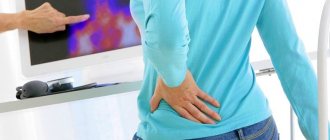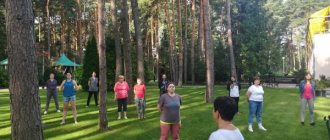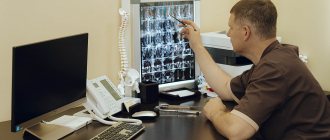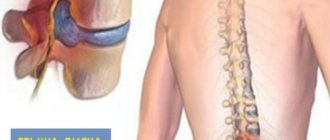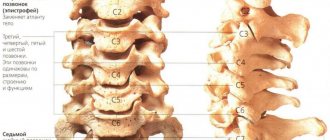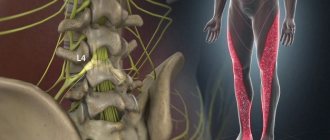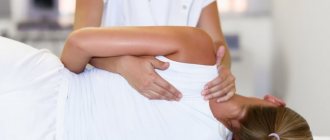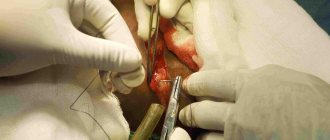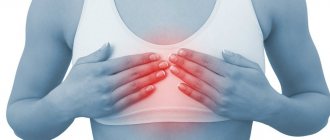Osteochondrosis (degenerative disc disease) in the lumbar spine or lower back is caused by involutional changes in the discs, which leads to lower back pain.
Intervertebral discs are tough, fibrous structures that act as ligaments between vertebrae, absorbing shock and providing shock absorption to the spine. The discs are flexible but strong enough to facilitate movements such as bending your torso forward, backward or sideways.
Despite the name, osteochondrosis is not considered a true disease and symptoms usually do not worsen over time. Discs, like all structures of the body, degrade as we age, and disc degeneration develops in all people as part of the involutionary process.
A characteristic feature of osteochondrosis is a gradual decrease in symptoms as the spine begins to stabilize. Treatment for lumbar spine degenerative disc disease focuses on minimizing pain, stabilizing the spine, and improving or maintaining mobility.
Symptoms
Most cases of manifestation of osteochondrosis of the lumbar spine consist in the presence of minor, constant back pain, which intensifies from time to time for several days or more.
Symptoms may vary, but the most common include:
- Moderate, constant pain in the lower back. Pain in the area of the damaged disc is the most common symptom of disc degeneration. The pain may radiate to the buttocks, groin and upper thighs. This pain usually feels dull and can range in intensity from mild to severe.
- Periodic acute episodes of pain. Back pain may get worse for a few days or weeks and then return to a more mild level. Flare-ups of pain occur as the spine degenerates and subside as the spine gradually stabilizes. Flare-ups of pain can occur suddenly and pain often results in decreased mobility.
- Local soreness. The area of the lower back surrounding the degenerated disc may be tender to the touch. Local soreness is caused by inflammation and muscle tension in the area of the disc damaged by degeneration.
- Leg pain. Neurological symptoms, including numbness, weakness, or sharp, shooting pain in the buttocks, thighs, and/or back of the leg, may be felt if the height of the disc is significantly reduced and conditions for nerve root compression occur. Pain in the legs with osteochondrosis of the lumbar spine usually does not fall below the knee.
- A feeling of sudden weakness or instability may occur when the disc is significantly weakened and the patient feels as if the lower back is not functioning properly.
In addition, the pain may increase or decrease with certain movements or certain postures, such as:
- Pain when sitting. Sitting for long periods often causes lower back pain and stiffness to worsen and is relieved by standing up or changing positions.
- Increased pain when bending or rotating. Twisting the spine and bending forward, backward, or sideways can cause intense, pain in the area of the damaged disc.
- Reduced pain when walking or changing position. When the spine changes position, the pressure on the discs is reduced or redistributed from the discs to the muscles and joints. Changing positions frequently, alternating between standing and sitting, and short walks can help relieve stiffness and keep pain to a minimum.
Disc degeneration should not cause symptoms of bowel/bladder dysfunction, fever with back pain, unexplained and rapid weight loss, or intense abdominal pain. These symptoms indicate more serious conditions and often require surgical treatment.
Associated symptoms
With osteochondrosis of the lumbar spine, in addition to low back pain, other symptoms associated with disc degeneration may occur. For example:
- Proteins contained within the disc can cause significant inflammation if they come into contact with the surrounding spinal structures, and this inflammation can lead to spasms of the lower back muscles as well as radicular pain radiating to the hips and the back of the lower extremities (also called sciatica).
- Lumbar disc degeneration can contribute to the development of lumbar stenosis and/or lumbar osteoarthritis, as well as other conditions in the lower back.
- A degenerated disc can also lead to a herniated lumbar disc. Neurological symptoms from a herniated disc can be acute and intense.
- Symptoms caused by disc degeneration in the lumbar spine can vary widely depending on how quickly or completely the disc degenerates and how it affects surrounding spinal structures.
- Pain from osteochondrosis is usually caused by deformation of the muscles that support the spine and inflammation around the structures adjacent to the disc.
How is a patient treated during an exacerbation?
Medicines for osteochondrosis
During an exacerbation, the most important thing is to relieve pain. This is usually expressed in injections of the necessary medications, since this is how the drugs are most digestible and effective. Later, when the symptoms become weak enough, the patient is given tablets.
It is necessary to treat exacerbation of neck osteochondrosis on time and as completely as possible. This is due to the fact that it is through the cervical spine that vital vessels and nerves pass, and inflammation can block them, which is fraught with very serious consequences.
Causes of osteochondrosis of the lumbar spine
Osteochondrosis occurs due to age-related wear and tear of the disc structure, and the degeneration process can be accelerated by injury, general condition, health and lifestyle, and possibly a genetic predisposition to the development of pathological processes in the musculoskeletal system.
Osteochondrosis rarely begins with a serious injury, such as a car accident. It is more likely that the initiation of degenerative processes is associated with low-energy disc trauma.
Low back pain associated with lumbar osteochondrosis is usually generated by one or more pathological processes:
- Inflamed, proteins from the disc irritate surrounding nerves - both small nerves in the disc itself and potentially large nerves that go to the legs (sciatic nerve).
- Abnormal micromotion instability when the outer rings of the disc, called the annulus fibrosus, wear out and cannot effectively absorb force vectors onto the spine, resulting in movement along the vertebral segment.
- Over a long period of time, pain from osteochondrosis of the lumbar spine eventually decreases, rather than getting worse. This pain relief occurs because the fully degenerated disc no longer has any inflammatory proteins (which can cause pain) and the collapsed disc moves into a stable position, eliminating the micro-movements that cause pain.
Preventive recommendations
Having studied the symptoms and treatment of osteochondrosis of the lumbosacral spine, you need to familiarize yourself with preventive measures. They include:
- nutritious nutrition with a high content of nutrients, minerals and vitamins;
- adequate physical activity;
- exclusion of injuries and damage to the spine, as well as any unfavorable factors;
- treatment of chronic foci of infection in the body and diseases that negatively affect the musculoskeletal system.
Knowing what osteochondrosis of the sacral spine is, symptoms and treatment in women, as well as preventive measures, is especially important when planning pregnancy and gestation.
Risk factors
Lifestyle factors that affect overall health can affect intervertebral discs. Risk factors for degenerative disc disease (osteochondrosis) include:
- Family history of back pain or musculoskeletal disorders
- Excessive stress on the lower back due to sports or the nature of work
- Prolonged static loads on the discs due to prolonged sitting and/or poor posture
- Lack of disc support due to weak back muscles
- Obesity
- Smoking or any form of nicotine consumption
Disc degeneration is part of the aging body, but not all people develop pain or any specific symptoms. Symptoms tend to occur when there is instability, muscle tension, and possibly nerve root irritation.
Lifestyle correction
The first thing the doctor does after discovering lumbosacral osteochondrosis is to recommend that the patient make a number of specific changes to his lifestyle. They will vary in different cases and depend on individual characteristics. So, if the patient is overweight, he will be advised to take measures to eliminate it. This could be a transition to a more rational, healthy diet, or an increase in the level of physical activity. But any grueling workouts and one-component diets for weight loss are strictly contraindicated!
If lumbosacral osteochondrosis is diagnosed in an office worker, he is advised to increase the level of physical activity. As a rule, it is worth leaving your workplace every hour to stretch and restore normal blood circulation in all parts of the body. It is also recommended to walk outdoors more often. This will not only help you feel better, but will also help improve your sleep quality.
With the development of lumbosacral osteochondrosis in people engaged in heavy physical labor or prone to frequent grueling workouts, they will, on the contrary, be recommended to reduce the load on their back or even change the type of activity. Weightlifting, wrestling, and jumping sports are contraindicated for this disease.
Diagnostics
- The medical history includes a detailed study of the patient's symptoms, their intensity and the relationship of pain with exercise or body position. Information about regular physical activity, sleep habits, and past injuries is also needed.
- A physical examination is necessary to examine range of motion and muscle condition. The presence of painful areas on palpation or physical abnormalities is also determined. In addition, neurological tests are performed to determine neurological deficits.
- The above diagnostic methods are usually sufficient to diagnose osteochondrosis, but an accurate diagnosis requires the use of imaging methods.
- CT
- Radiography
- MSCT
- PAT
- MRI is a diagnostic method that allows you to clarify the degree of degeneration, the presence of fractures, herniated discs and stenosis. Often, an MRI examination is necessary in preparation for surgical treatment in order to accurately determine the location of the degenerated disc and plan the operation.
Studies have shown that MRI findings of moderate to severe disc degeneration are found in scans of patients with both severe pain and minimal or no pain. In addition, many disease conditions may not show up on MRI. For this reason, the diagnosis cannot be made solely on the basis of imaging results, and verification of the diagnosis is possible only on the basis of a combination of all clinical and instrumental examination methods.
Treatment
Initial treatments for lumbar spine osteochondrosis and pain usually include the following combinations:
- Over-the-counter pain relievers
such as aspirin (Bayer), ibuprofen (Advil), or naproxen (Aleve) can reduce inflammation that contributes to discomfort, stiffness, and irritation of the nerve roots. - Prescription pain medications
. For severe pain, muscle relaxants or narcotic painkillers may be prescribed. These drugs are usually used to treat intense, sharp pain that is not expected to last more than a few days or weeks. These medications can be addictive and cause serious side effects, so they should be used with caution. - Heat and ice
. Applying heat to the lower back improves blood circulation, which reduces muscle spasms and tension and improves mobility. Ice packs can reduce inflammation and relieve mild pain. It is helpful to apply heat before exercise to relax muscles and to apply ice after exercise to minimize inflammation. - Manual therapy.
Manipulation by a specialist is a popular method of pain management for low back pain. Medical practitioners called chiropractors use their hands to manipulate different areas of the body to relieve tension in muscles and joints. Manipulation has been found to be an effective measure for temporarily reducing pain, and in some cases is as effective as drug therapy. - Massage
. Massage techniques can reduce tension and spasms in the muscles of the lower back, reduce pressure on the spine and relieve pain. In addition, therapeutic massage can improve blood circulation, delivering nutrients and oxygen to tight muscles. - Epidural steroid injections
(ESI). Injecting a steroid into the space surrounding the spine can reduce pain impulses as well as inflammation. A steroid injection can be used in conjunction with a physical therapy program to relieve pain during exercise and rehabilitation. Typically, an epidural steroid injection can reduce pain for a period of several weeks to one year.
In many cases, a combination of treatments is necessary for effective pain relief. A process of trial and error is usually necessary to find the treatment that will be most effective.
Prolonged bed rest is not recommended, and immobilization is generally possible for severe pain for a short period of time, as lack of physical activity can weaken the muscles and normal support of the spine.
Forms of release of medicines
Medicines are offered in pharmacies in various forms: ointments, tablets, injections. The doctor selects the appropriate one, taking into account the patient’s severe symptoms, concomitant diseases, and chronic pathologies. Many types of painkillers are contraindicated for injections in the presence of pathologies of the kidneys, liver or stomach.
Tablets and capsules
The most convenient and simple form of medicines that is used during the treatment of osteochondrosis. You can take the tablets with you, so you don’t have to interrupt treatment while traveling or on a business trip, and it’s easier to calculate the required dosage. The active substance is in a gelatin or other shell, which dissolves only in the intestines. This eliminates the premature destruction of components due to the negative effects of gastric juice. The tablets are prescribed:
- Analgesics.
- Non-steroidal anti-inflammatory drugs.
- Muscle relaxants.
- Vitamin complexes.
Tablets and capsules are prescribed mainly during outpatient treatment. When staying in a hospital, it is more advisable to use injections, since the likelihood of an allergic reaction to one of the components of the drug is lower.
Ointments and gels
If there are a large number of contraindications, doctors prescribe products for external use. These can be balms, creams, gels or ointments that act locally on the affected area. They are non-toxic, and the active substance reaches the right place through the skin and has the desired effect. The main drugs used in the form of ointments:
- "Viprosal."
- "Finalgon"
- "Capsicam."
- "Gevkaman."
The big advantage is minimal entry into the bloodstream, which eliminates the likelihood of developing systemic side effects. Ointments can be used simultaneously with tablets or injections, which allows you to reduce the dose of drugs and minimize the burden on the patient’s body.
Injections
Solutions for intramuscular or intravenous administration are used mainly for inpatient treatment of a patient. They can effectively relieve severe pain, eliminate swelling and inflammation. For intolerable radicular syndrome, blockades using Novocaine or Lidocaine are used. They are injected directly into the lesion and allow you to eliminate unpleasant sensations for a long time.
One of the advantages of this dosage form is the rapid onset of the therapeutic effect, eliminating stiffness of movement within a few minutes. The effect of use lasts for several days.
Exercise therapy and activity modification
Exercise is essential to maintaining healthy spinal mobility. An effective exercise program for the lumbar spine should include:
- Stretching exercises for the muscles of the lower back, hips and pelvis, as well as the harmstring muscles. Tightening of these muscles increases pressure on the lumbar spine and contributes to the development of lower back pain.
- Strengthening your lower back and abdominal muscles helps you maintain good posture and better support your spine. A muscle strengthening exercise program may include an individual exercise program, dynamic lumbar spine stabilization, tai chi, Pilates, or others.
- Low-impact aerobic exercise, which increases your heart rate, improves blood circulation and the supply of nutrients and oxygen needed to repair body tissues. For example, this could be walking, swimming and water aerobics.
Exercise programs are usually tailored on a case-by-case basis, depending on your overall health, severity of pain, and personal preference.
In addition, small adjustments to daily activities (lifestyle modifications) can effectively alleviate pain. For example, wearing a brace when lifting heavy objects or avoiding twisting when lifting heavy objects can prevent increased pain due to excessive stress on the discs. Using an ergonomic chair and orthopedic mattress can also improve your posture and reduce stress on your discs.
Prevention of pathology
Exacerbations of osteochondrosis can be prevented by observing the following rules:
- properly organize work and rest;
- sit comfortably;
- lie and stand correctly;
- do not lift excessive weights.
To avoid such a disease, it is worth taking simple preventive measures.
Professional recommendations:
- You should not sit on soft ones. For sedentary work, a firm chair is required, the back of which reaches to the middle of the head. Moreover, the seat should be located at a height of 2/3 of the thigh length so that the legs are on the floor;
- You can’t slouch while sitting either;
- once every 15 minutes you need to change your position;
- for sleeping, use an orthopedic mattress or at least just a hard surface;
- if you have to carry heavy loads, load your arms equally;
- to lift weights, do not bend over, but squat down, while keeping your back straight;
- If possible, try to do self-massage.
Surgery
Surgical treatment of osteochondrosis of the lumbar spine is necessary in cases where conservative treatment for 6 months was ineffective. Surgical treatment for osteochondrosis is always selective, which means that the patient himself decides whether to undergo surgery or not.
It is recommended that all factors be taken into account before deciding to undergo surgery for osteochondrosis, including the length of the recovery period, pain management during recovery, and spinal rehabilitation.
Vertebral fusion surgery
The standard surgical treatment for lumbar spine degenerative disc disease is fusion surgery, in which two vertebrae are fused together. The purpose of fusion surgery (spinal fusion) is to reduce pain and eliminate instability in the motion segment of the spine.
All spinal fusion surgeries consist of the following:
- The damaged disc is completely removed from the intervertebral space (discectomy).
- Stabilization is carried out using bone graft and/or instrumentation (implants, plates, rods and/or screws).
- The vertebrae then fuse to form a solid, immobile structure. Fusion occurs within a few months after the procedure, and not during the operation itself.
After the operation, wearing a corset and taking analgesics are prescribed. Physical exercises are included very carefully, taking into account the individual characteristics of the patient and the degree of tissue regeneration. Full recovery from fusion surgery may take up to a year while the vertebrae fuse together.
Surgical replacement with artificial disc
Replacing a damaged disc with an artificial implant has been developed in recent years as an alternative to fusion surgery. Disc replacement surgery consists of completely removing the disc damaged by degeneration (discectomy), restoring the disc space to its natural height, and implanting an artificial disc.
This procedure is designed to maintain motion in the spine similar to natural motion, reducing the likelihood of increased pressure on adjacent spinal segments (a common complication of spinal fusion).
Recovery from disc replacement surgery usually lasts up to 6 months.
Secrets of traditional medicine
With osteochondrosis, not only official medicine helps, but also a variety of folk remedies. Warming and anti-inflammatory compresses, herbal decoctions, and various ointments have proven themselves to be quite effective.
Traditional medicine methods can contribute to better treatment of such pathology
A decoction of burdock (thistle) leaves is a good pain reliever. The compress can be left overnight.
Taking a warm bath with pine needle, knotweed and/or chamomile extract can help relax your muscles and reduce pain.
If you drink lilac tincture and/or a decoction of St. John's wort and burdock (thistle) roots, you can relieve pain.
